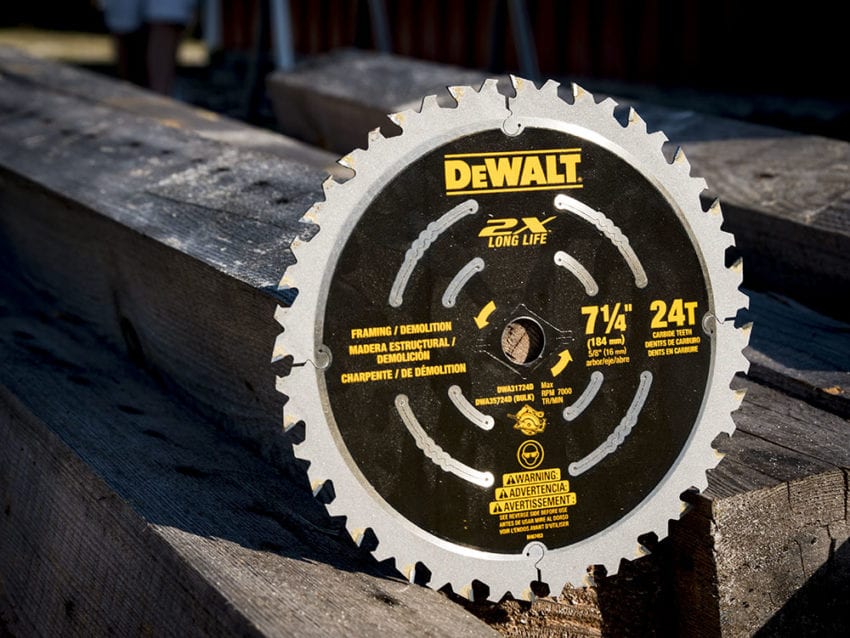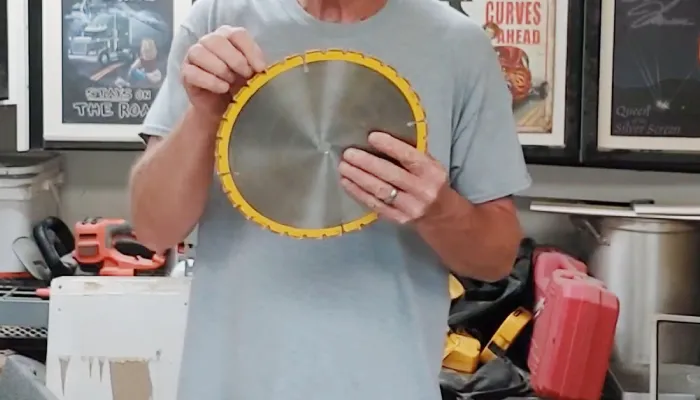Have you ever wondered how long a circular saw blade lasts? Well, you’ve come to the right place! In this article, we’ll explore the lifespan of a circular saw blade and provide you with some helpful insights. So, let’s dive right in and discover the secrets behind the longevity of these essential tools.
Now, you might be thinking, “Why should I even care about the lifespan of a circular saw blade?” Well, let me tell you, my friend, understanding how long a blade can last can save you time, money, and a whole lot of frustration. Whether you’re a seasoned woodworker or just starting out, knowing when it’s time to replace your saw blade can make all the difference in the quality of your work.
So, how long can you expect a circular saw blade to last? The answer, my young apprentice, depends on a few factors. The type of blade, the material you’re cutting, and how well you maintain it all play a role in determining its lifespan. But fear not! We’re here to guide you through it all and help you make the most of your circular saw experience. Let’s get started!

How Long Does a Circular Saw Blade Last?
When it comes to using a circular saw, the blade is a critical component that determines the quality and efficiency of your cuts. But how long can you expect a circular saw blade to last before it needs to be replaced? In this article, we will explore the factors that affect the lifespan of a circular saw blade and provide valuable tips to help you maximize its longevity. Read on to discover everything you need to know about the lifespan of a circular saw blade.
Factors That Affect the Lifespan of a Circular Saw Blade
Understanding the factors that can impact the lifespan of a circular saw blade is essential for maintaining its optimal performance. Here are some key factors to consider:
1. Blade Material
The material used to make the blade plays a significant role in determining its longevity. Circular saw blades are commonly made from different types of steel, such as high-speed steel (HSS), carbide-tipped steel, and diamond-tipped steel. Carbide-tipped blades tend to last longer than HSS blades, while diamond-tipped blades are ideal for cutting through tough materials like tile and concrete.
2. Cutting Material
The type of material you are cutting with the saw blade also affects its lifespan. Cutting through softwoods like pine or cedar is less taxing on the blade compared to hardwoods like oak or maple. Additionally, cutting through abrasive materials or materials with embedded nails or screws can significantly shorten the lifespan of the blade.
3. Blade Coating
Some circular saw blades come with specialized coatings that enhance their durability and performance. For example, blades with a Teflon or titanium coating have reduced friction, which minimizes heat buildup and extends the blade’s lifespan. Consider opting for a blade with a coating that suits the materials you frequently work with.
4. Cutting Technique
Using proper cutting techniques can help prolong the life of your circular saw blade. Applying excessive force, forcing the blade through the material, or using a dull blade can all contribute to premature wear and tear. Make sure to use the appropriate blade for the material you are cutting and allow the blade to do the work without exerting excessive pressure.
5. Maintenance and Care
Proper maintenance and care are crucial for extending the lifespan of a circular saw blade. Keep the blade clean and free of debris, as buildup can cause friction and heat, leading to premature wear. Regularly inspect the blade for signs of dullness or damage, and sharpen or replace it as needed. Storing the blade safely in a protective case when not in use can also help prevent damage.
Key Tips for Maximizing the Lifespan of a Circular Saw Blade
Now that you are aware of the factors that can affect the lifespan of a circular saw blade, here are some valuable tips to help you get the most out of your blade:
1. Choose the Right Blade for the Job
Using the appropriate blade for the material you are cutting is crucial for optimizing its lifespan. Consider factors such as tooth count, blade thickness, and specialized coatings to ensure you have the right blade for the task at hand.
2. Use Proper Cutting Techniques
Applying the correct cutting techniques will not only result in cleaner cuts but also help prolong the life of your blade. Let the blade do the work, using a steady and controlled cutting motion. Avoid forcing the blade through the material or cutting at excessively high speeds.
3. Regularly Clean and Inspect the Blade
Take the time to clean your blade regularly, removing any debris or residue that may have accumulated during use. Inspect the blade for signs of wear, dullness, or damage, and address any issues promptly. This will ensure optimal performance and extend its lifespan.
When to Replace Your Circular Saw Blade
Despite taking proper care of your circular saw blade, there will come a time when it needs to be replaced. Here are a few signs that indicate your blade is no longer functioning at its best:
1. Dullness
If you notice that your blade is struggling to make clean cuts and requires more effort on your part, it may be time for a replacement. Dull blades can result in splintering, tear-out, and rough cuts.
2. Chipped or Damaged Teeth
If the teeth on your saw blade are chipped, worn down, or otherwise damaged, it is best to replace the blade. Damaged teeth can lead to uneven cuts and decrease the safety of your cutting operations.
3. Excessive Vibration or Noise
If you experience excessive vibration or noise while using your circular saw, it could be a sign that the blade is no longer properly balanced. In such cases, it is advisable to replace the blade to maintain safe and efficient cutting.
In Summary
A circular saw blade can last anywhere from a few months to several years, depending on various factors such as the blade material, cutting technique, and maintenance. By understanding these factors and following the tips provided, you can maximize the lifespan of your circular saw blade and ensure optimal performance. Keep an eye out for signs of wear and damage, and replace the blade when necessary to maintain safe and precise cutting. With proper care, your circular saw blade will serve you well for many projects to come.
Key Takeaways: How Long Does a Circular Saw Blade Last?
- A circular saw blade typically lasts around 40-60 hours of cutting time.
- The lifespan of a circular saw blade can be influenced by factors like material being cut, blade quality, and maintenance.
- Using a blade that is appropriate for the material being cut can help extend its lifespan.
- Cleaning and lubricating the blade regularly can help prevent overheating and maintain its cutting efficiency.
- Inspecting the blade for signs of wear, such as dullness or chips, and replacing it when necessary is crucial for safety and optimal performance.
Frequently Asked Questions
Welcome to our Frequently Asked Questions section about circular saw blades. Here, you’ll find answers to common queries regarding the lifespan and durability of these essential tools.
How often should I replace my circular saw blade?
The lifespan of a circular saw blade can vary depending on several factors, such as the type of material being cut, the quality of the blade, and the frequency of use. On average, a good-quality blade used for general woodworking can last anywhere from 40 to 60 hours of cutting time. However, if you are routinely making heavy-duty cuts or working with abrasive materials like concrete or metal, the blade may wear out more quickly. It’s essential to monitor the blade’s condition and replace it as soon as you notice signs of dullness or damage, such as splintering cuts or excessive heat generation.
To ensure optimal performance and safety, it’s also recommended to follow the manufacturer’s guidelines for blade replacement. Keep in mind that proper maintenance, such as regular cleaning and sharpening, can extend the lifespan of your blade.
What are the signs that my circular saw blade needs to be replaced?
There are a few telltale signs that indicate it’s time to replace your circular saw blade. First, pay attention to the quality of your cuts. If you notice more splintering or rough edges, it could be a sign that the blade is getting dull. Excessive heat generation during cutting is another warning sign. If the blade starts to emit a burning smell or becomes too hot to touch, it’s likely time for a replacement.
Inspect the blade for visible signs of damage, such as missing or chipped teeth. Blades with missing teeth can compromise the quality of your cuts and pose a safety risk. Additionally, if you notice an increase in noise or vibration while using the saw, it may indicate a worn-out blade. If you experience any of these issues, it’s best to replace the blade promptly.
Are there any measures I can take to extend the lifespan of my circular saw blade?
Yes, there are several steps you can take to prolong the lifespan of your circular saw blade. First and foremost, always use the appropriate blade for the material you are cutting. Using a blade designed for wood on metal, for example, can cause excessive wear and damage. Additionally, ensure the blade is properly installed and securely tightened in the saw.
Regular cleaning is also crucial. Remove any debris or resin buildup from the blade after each use. You can use a brush or a specialized cleaning solution to remove stubborn residues. It’s also beneficial to lubricate the blade periodically to reduce friction during cutting.
Can I sharpen a dull circular saw blade or should I replace it?
In some cases, you can sharpen a dull circular saw blade to restore its cutting performance. However, this should only be done if you have the necessary skills and equipment to do it properly. If you are unsure or unfamiliar with the sharpening process, it’s best to replace the blade or seek assistance from a professional. Improper sharpening can result in an uneven blade and compromise the quality of your cuts.
Keep in mind that sharpening a blade can only extend its lifespan to a certain extent. Eventually, even a sharpened blade will wear out and need replacement. If you find yourself sharpening the blade frequently or notice a significant decrease in performance, it’s likely time for a new one.
What are the best practices for storing circular saw blades?
To ensure the longevity of your circular saw blades, proper storage is essential. It’s advisable to keep the blades in a clean and dry environment to prevent rust and corrosion. Some professionals recommend using blade covers or cases for individual blade storage, while others suggest using blade cabinets or racks to keep them organized and protected.
Avoid storing blades in damp or humid conditions, as this can promote rust formation. Make sure the blades are not in contact with other tools or materials that could cause damage. When transporting the saw blades, use protective covers and handle them with care to prevent accidental bumps or drops. By following these storage practices, you can maintain the quality and performance of your circular saw blades over an extended period.

Summary
So, to sum it up, circular saw blades can last anywhere from 10 to 100 hours of cutting. However, several factors can affect their lifespan, such as the type of material being cut, the quality of the blade, and how well it is maintained. It’s important to keep an eye out for signs of wear and tear, like dull teeth or excessive vibration, and replace the blade as needed. Remember, taking proper care of your circular saw blade will help it last longer and ensure safer and more efficient cutting.
